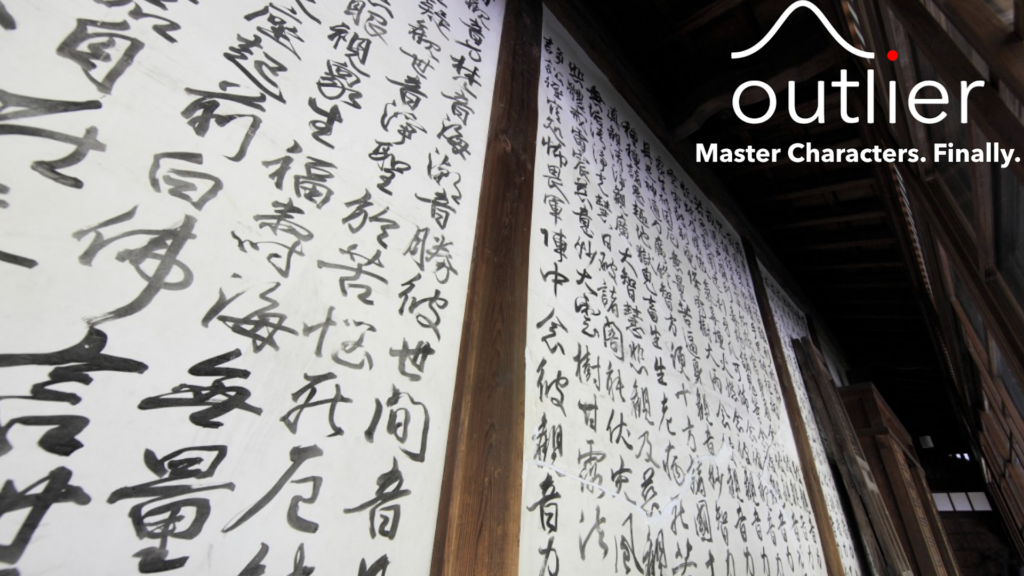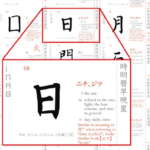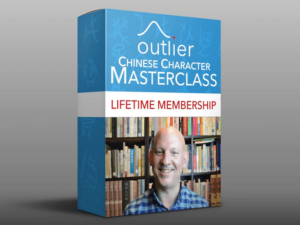 To become literate in Chinese, you need to learn thousands of characters. For some, characters are beautiful and alluring, rich with cultural and historical significance. For others, learning characters feels overwhelmingly complex and tedious.
To become literate in Chinese, you need to learn thousands of characters. For some, characters are beautiful and alluring, rich with cultural and historical significance. For others, learning characters feels overwhelmingly complex and tedious.
Most of us fall somewhere in between and may move across the spectrum over time. Regardless of whether you like them or not, becoming literate in Chinese requires an effective strategy for learning characters.
Tune in to the Hacking Chinese Podcast to listen to the related episode #186:
Available on Apple Podcasts, Google Podcasts, Overcast, Spotify, YouTube and many other platforms!
The challenge: Learning thousands of Chinese characters as an adult
The first strategy that comes to mind might be to check how Chinese people do it. After all, there are more than a billion people in the world who can read and write Chinese, so investigating how they achieved it seems like a good idea. However, this is not the case!
Foreign adults can’t learn Chinese characters the way native speakers do because the learning contexts and timeframes differ significantly. Native speakers spend over a decade immersed in the written language, with hours upon hours of both active and passive practice every day. They are also fluent in the spoken language before they start learning characters seriously.
This is impossible to replicate for adult learners of Chinese as a second language. Adopting the methods native speakers are forced to endure in school to learn to write characters, such as writing them dozens or hundreds of times, copying longer passages by hand, or doing lots of dictation, is terribly inefficient. Most students also find it mind-numbingly boring.
Outlier Chinese Character Masterclass review: Understand more, learn faster, remember longer
Fortunately, there are better ways of learning characters. In this review, I will introduce the Outlier Chinese Character Masterclass and explain why I think it’s one of the best resources around for levelling up your character learning. I have structured my review as follows:
- Understand more, learn faster, remember longer: Four levels of understanding
- Outlier Chinese Character Masterclass: A unique resource
- What is the Outlier Chinese Character Masterclass?
- Level up your Chinese character learning with Outlier Linguistics
- Who is the Outlier Chinese Character Masterclass for?
- Outlier Chinese Character Masterclass: How does it compare with other character courses?
- Downsides and room for improvement
- Other products from Outlier Linguistics
- Conclusion of my review: Understand more, learn faster, and remember longer with the Outlier Chinese Character Masterclass
- Comments and discussion
Understand more, learn faster, remember longer: Four levels of understanding
There are better ways to learn Chinese characters, though. Instead of relying on rote memorisation, where you try to learn by repeating something without understanding it, you should strive to understand what you’re doing. This is one of the most fundamental principles of remembering anything, not just Chinese characters. If you understand something, it will stick in your mind, but if you don’t, it will quickly disappear. Unless you repeat it over and over for the rest of your life, of course, but most people have better things to do with their time.
So, what does understanding Chinese characters mean? How can you make learning Chinese characters meaningful? Let’s have a look at four different levels of understanding to show how levelling up your knowledge of the Chinese writing system will help you master characters.
- Thinking that characters are a jumble of strokes (weakest) – If you think of characters as a jumble of strokes, learning thousands of them becomes an insurmountable task. This would essentially be like trying to remember thousands of stylised pictures without any inherent relationship or meaning. This is where we all start as beginners, but we quickly realise that there’s more to Chinese characters than just strokes.

- Realising that characters are compounds with recurring components (weak) –When you’ve seen a bunch of characters, you’ll notice that certain parts recur in different characters. Soon, you’ll realise that most characters are compounds that consist of smaller components and that these components are usually not unique to the compound they are in. For example, 好 (hǎo), “good”, consists of 女 (nǚ), “woman”, and 子 (zǐ), “child”. You then also see that 妈 (mā), “mother” also includes the same component; amazing! This reduces the problem of learning thousands of characters to learning hundreds of components, plus how they are combined. This is where most students, and most teachers, stop.

- Knowing what function each component has in a compound (strong) – Realising that most Chinese characters are compounds is great, but it’s not enough to understand how Chinese characters work. In the character 好 (hǎo), “good”, both components are semantic (relating to meaning), but this is an exception. And while it’s not far-fetched to think that “woman” and “child” combined can express “good”, what on earth is going on in 妈 (mā), “mother”? While “woman” makes sense, 马 (mǎ), “horse”, seems off. The truth is that this component is phonetic, not semantic, meaning that its function is to indicate sound. You might have noticed that the pronunciations of the two characters are similar! This level of understanding, then, involves understanding not just what components are, but also which function(s) they have in any given character.

- Understanding how functional components work (strongest) – Once you realise that sound plays an important role in the formation of characters, such as in 妈 (mā), “mother”, a whole new world will open up for you, and thing that seemed odd or confusing will start making sense. You’ll be able to identify sound series that share the same phonetic components. As you learn more, you will also realise that there are two types of semantic components: meaning and form. There are also empty components that don’t have any function at all. Finally, you’ll start understanding how all these things interact to form Chinese characters, both now and throughout history!

All this is about relying on the power of understanding to make it easier to learn Chinese characters. Understanding how the writing system works is not the only important part of a successful strategy, but it is essential and what we’re focusing on in this article.
Outlier Chinese Character Masterclass: A unique resource
The problem is finding reliable information about how characters work, both in specific cases and in general.
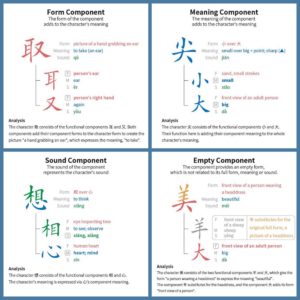 The first level (strokes) is very easy; I have compiled the best resources for learning strokes and stroke order here already.
The first level (strokes) is very easy; I have compiled the best resources for learning strokes and stroke order here already.- The second level (components) is also easy. Most tools and apps for learning Chinese characters provide you with a way to break compounds into their components. A good example is HanziCraft.
- The third level (functional components) is harder because most resources won’t show you if a component is semantic, phonetic, both or none. My favourite free resource for this is zi.tools, but it takes some getting used to and works better if you already know what you’re doing.
- The fourth level used to be impossible unless you already knew Chinese and were willing to invest a lot of time into reading academic research in the language, in which case it would be too late to use what you learnt to master characters anyway.
That is, it used to be impossible before Outlier Linguistics released their Chinese Character Masterclass!
What is the Outlier Chinese Character Masterclass?
The Outlier Chinese Character Masterclass is a video course that will level up your character learning. Most importantly, it will help you understand how the Chinese writing system works, enabling you to understand the structure underlying all characters, which will be immensely helpful on your journey towards learning to read and write Chinese.
This is the unique selling point that no other resource does better than Outlier; they have both the personal experience and academic credentials to explain things in a way that makes sense and is also practically applicable to your studies.
You can learn more about the course here: Outlier Chinese Character Masterclass
With the discount code “hacking25” (without quotation marks), you’ll get 25% off anything from Outlier Linguistics. If you find something interesting on their site, please use the links in this article, as that also helps support Hacking Chinese and enables me to keep publishing free articles and podcast episodes.
Beyond, the core, the course also covers effective strategies for learning characters, including an overview of how memory works and how you can apply scientifically sound methods to make sure you remember the characters you learn. These sections of the course are great, but not unique to this course in particular. For example, I provide similar advice for free in my article My best advice on how to learn Chinese characters.
When evaluating any product, it’s important to take the people behind the product into account. The core of the Outlier Linguistics team is Ash Henson and John Renfroe, who have both learnt Chinese to an advanced level as adults. Not only that, they have pursued academic studies and research in Chinese characters and palaeography (the study of historical writing systems), in Ash”s case, up to a PhD and beyond. You can read more about them here if you want!
In the rest of this article, I will explain how Outlier Linguistics has helped me learn Chinese characters, and how they can help you too!
Level up your Chinese character learning with Outlier Linguistics
To give you a better idea of what the course contains, here’s an overview of the three units:
Unit I: Intro and Foundations
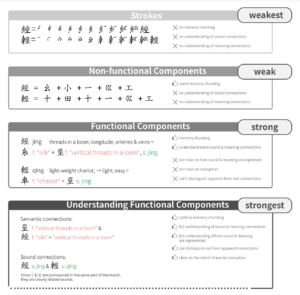 This part of the course goes through the fundamentals of learning characters, a bit similar to what I’ve done in this article, but in more detail and with more examples.
This part of the course goes through the fundamentals of learning characters, a bit similar to what I’ve done in this article, but in more detail and with more examples.
- Lesson 0: Intro to the course/what to expect
- Lesson 1: Rules of Memory
- Lesson 2: Three Attributes of Writing/Three Functions
- Lesson 3: Deep Structure, Surface Structure, and Stroke Order
Unit II: How Chinese Characters Actually Work
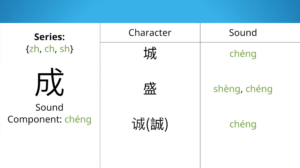 This is the core of the course, the things you really can’t get anywhere. Even if you have been learning Chinese for a decade, taken a dozen university courses and read all the articles on Hacking Chinese, you will still find this unit eye-opening.
This is the core of the course, the things you really can’t get anywhere. Even if you have been learning Chinese for a decade, taken a dozen university courses and read all the articles on Hacking Chinese, you will still find this unit eye-opening.
If you haven’t been learning Chinese for that long, you build a solid foundation on which future character learning will rest. If you’re already an advanced learner, there will be many aha moments that are not just satisfying, but also highly useful in expanding and maintaining your vocabulary.
- Lesson 4: Form Components
- Lesson 5: Meaning Components
- Lesson 6: Sound Components
- Lesson 7: Sound series (characters with the same sound component)
- Lesson 8: Empty Components
- Lesson 9: All about character meanings
Unit III: Tips Strategies for Learning More Effectively
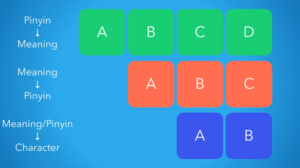 This part attempts to combine the two earlier parts and help you apply what you have learnt in practice. While the main purpose of the course, as I perceive it, is to teach you how the Chinese writing system works, you also need to be able to apply this in practical situations, which is what these strategies and methods are meant to help you do:
This part attempts to combine the two earlier parts and help you apply what you have learnt in practice. While the main purpose of the course, as I perceive it, is to teach you how the Chinese writing system works, you also need to be able to apply this in practical situations, which is what these strategies and methods are meant to help you do:
- Lesson 10: The “IME Method”
- Lesson 11: Spaced Repetition
- Lesson 12: The Pipelining Strategy
- Lesson 13: The Minimalist Strategy
Each lesson is taught through concise video clips, often one per lesson, but sometimes as many as three. Each video covers the core content but also comes with PDF documents (choose simplified or traditional characters) that often go a bit deeper, and also add more examples and explain the vocabulary covered in the lesson. There are also quizzes to help you verify that you have understood the teaching material correctly.
Who is the Outlier Chinese Character Masterclass for?
I think the Outlier Chinese Character Masterclass is most suitable for intermediate and advanced learners.
 I have followed Outlier Linguistics since at least 2013 and my approach to characters has been deeply influenced by discussions with them and the products that they offer, primarily this course and their Chinese character dictionary. When I first met them, I had learnt Chinese for roughly six years and was enrolled in a master’s program for teaching Chinese as a second language in Taiwan, where the Outlier team was located at the time.
I have followed Outlier Linguistics since at least 2013 and my approach to characters has been deeply influenced by discussions with them and the products that they offer, primarily this course and their Chinese character dictionary. When I first met them, I had learnt Chinese for roughly six years and was enrolled in a master’s program for teaching Chinese as a second language in Taiwan, where the Outlier team was located at the time.
Even though I could read academic texts in Chinese, I still learnt much from them, and this is what later turned into their character dictionary and this masterclass. I mention this to highlight how rare and valuable this information is. I would have loved to have access to this course earlier, just as I would have paid a lot to get hold of the dictionary ten years before it was published. Even if you’re an advanced learner, you will not regret enrolling in this course!
This doesn’t mean that you have to already know thousands of characters to find this course interesting and useful. Quite the opposite: you’ll get more value out of it when you can use the information and advice in this course to help you learn all those characters!
No matter what level you’re on, this is a resource that will accompany you on your journey towards literacy in Chinese. If you combine it with the Outlier dictionary of Chinese characters, you will have access to all the knowledge you need. To get the perfect set-up, combine this with a tool like Skritter, which will enable you to also practise characters in the most efficient way possible.
Is the Outlier Chinese Character Masterclass suitable for beginners?
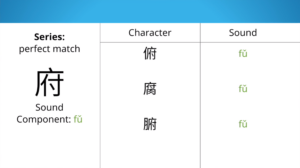
This is not very helpful if you know 100 characters in total. It’s extremely helpful if you know 1000, however.
That being said, it’s important to note that in this course, Ash and John don’t appear in front of the camera to explain 300 characters to you, one at a time, building your way from 0 to 300. They explain the deep structure behind the characters using various examples and then give you more characters to help you apply what you have learnt on your own through the included PDFs.
If you want someone to handhold your way to your first 300 characters, you need to look elsewhere. Also, if you just started learning to read and write characters and only know a handful, a majority of the examples shown in the course are characters that you haven’t learnt and maybe never seen, which makes the lesson content harder to absorb. In essence, if you want a course that teaches you a specific set of characters, such as the 300 most common ones, the Outlier Chinese Character Masterclass is not for you.
However, if you want to understand the principles underlying those 300 characters, and all the rest of them for that matter, thus making them easier to learn and remember, then the Outlier Chinese Character Masterclass is for you.
Outlier Chinese Character Masterclass: How does it compare with other character courses?
I’ve been interested in both learning and teaching characters for well over a decade, although my interest has shifted firmly towards teaching in recent years. Over the years, I’ve checked many Chinese character courses, both online and offline, so I think it would be a good idea to compare the Outlier Chinese Character Masterclass to all the other courses out there.
Wait, all the other courses out there? But there are dozens of them! Yes, that’s true, but as mentioned, I think that the Outlier Chinese Character Masterclass is a unique resource that deserves its own category.
To show you what I mean, let’s compare the Outlier course with the Chinese character course I have designed for Skritter. While not identical to other character courses you can find online, it can serve as an example to show in what way Outlies’ course is unique.
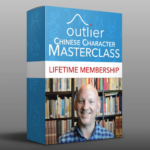 The Outlier Chinese Character Masterclass teaches you how the writing system truly works. Ash and John do not make things up or simplify them to the point of being incorrect just to make it easier for you. Naturally, they do their best to teach Chinese characters pedagogically, but they don’t compromise when it comes to the core aim of the course: to help you understand how characters work. For example, they use the best examples to illustrate various points, not the ones that can be illustrated with the cutest pictures.
The Outlier Chinese Character Masterclass teaches you how the writing system truly works. Ash and John do not make things up or simplify them to the point of being incorrect just to make it easier for you. Naturally, they do their best to teach Chinese characters pedagogically, but they don’t compromise when it comes to the core aim of the course: to help you understand how characters work. For example, they use the best examples to illustrate various points, not the ones that can be illustrated with the cutest pictures. The Skritter Chinese Character Course gives you an introduction to the same concepts but in a simpler way. It also assumes that you know nothing about Chinese characters and will only teach you characters that a beginner will find immediately useful. When designing this course, I did make certain pedagogical choices, which in my mind makes the course better for beginners (the target group), but worse for more advanced students. For example, I decided to not split semantic components into meaning and form components. This hides the true nature of the writing system, but it also makes it more manageable for complete beginners.
The Skritter Chinese Character Course gives you an introduction to the same concepts but in a simpler way. It also assumes that you know nothing about Chinese characters and will only teach you characters that a beginner will find immediately useful. When designing this course, I did make certain pedagogical choices, which in my mind makes the course better for beginners (the target group), but worse for more advanced students. For example, I decided to not split semantic components into meaning and form components. This hides the true nature of the writing system, but it also makes it more manageable for complete beginners.
All other character courses I’ve checked belong in the same category as the Skritter course, although most of them are considerably less rigorous and make enormous compromises with the content to make it more appealing. Who cares about how characters actually work if you can show a cute picture instead?
Anyway, the point is that if you want to unravel the mysteries of the Chinese writing system, you need to take a course from an expert in Chinese characters (Outlier Linguistics), not an expert in teaching Chinese (me), let alone from someone great at design and marketing.
Downsides and room for improvement
 No resource is perfect, and the Outlier Chinese Character Masterclass is no exception, so let’s have a look at some of the downsides. Most of these are not very consequential and might appear trivial, but my goal here is to provide an objective picture of the course so you know what you’re buying.
No resource is perfect, and the Outlier Chinese Character Masterclass is no exception, so let’s have a look at some of the downsides. Most of these are not very consequential and might appear trivial, but my goal here is to provide an objective picture of the course so you know what you’re buying.
Here are some points I think are worth mentioning:
- Not beginner-friendly. This is probably the only serious drawback, as explained above. The 300 characters this course teaches should not be the first 300 you learn. If you only know the 100 most common characters when you start, most of the examples in the course will be with characters you have never seen. This is not catastrophic, but it certainly reduces the value of the course.
- Requires independent learning. As mentioned above, Outlier will not hold your hand and go through each of the 300 characters in chirpy, Tiktok-friendly videos, but will instead teach you the principles that underpin the Chinese writing system using examples. The rest you need to do yourself. This is not a downside, in my opinion, but a sI know that some people complain about things like this in my courses, so I thought I’d mention it.
- Sometimes uninspired delivery. This is the first video course that the Outlier team produced, and it shows. While I find the content extremely interesting, I think lessons could be livelier and more natural. I would prefer some hesitation and rewording over someone reading a script all day. Still, this does not affect the awesome content, and I do feel a bit hypocritical writing this, as I’m not a video person myself and wouldn’t necessarily do better than they do. Also, you should of course check the sample lessons before purchasing!
- Sometimes low audio quality. While the graphics in the course are generally good (green screen, animations on screen to highlight what’s being commented on, etc.), the audio is sometimes not. You can hear traffic in the background, buzzing or just general noise. This does not make it hard to hear what they say in any way, but for a premium course, I expect better quality. Again, I didn’t do much better in my first course, but I feel I have to mention it here.
- Unclear information distribution between video and text. One thing I found a bit confusing is that the text documents contain much more information than the videos. I would have preferred if all the general content in the text documents were also available in the lessons themselves. I understand the need to put the actual character information in a PDF, and that’s fine, but it’s awkward to first listen to them talking about a principle, then read a text that covers almost the same things, but has added information that I might want! Either include everything in both the video and text or highlight what is new so I can read only that.
- Might be hard to put into practice. While the information and advice offered in this course are both spot on, I can imagine that some students will find it hard to apply, even considering that the third unit is largely about exactly how to apply the theory in practical situations. This is not really Outilers’ fault, but learning Chinese characters is a complicated process, and even with the knowledge presented in the course, you might often find yourself in situations where you’re not sure what to do next. This could have been alleviated by an extended workbook or practice section.
I’ve heard that Outlier is working on a new, updated version of the course, so hopefully they’ll fix some of these things!
Other products from Outlier Linguistics
Outlier Linguistics offer a wide range of products for people interested in Chinese or China. I have not tried all these myself, so I can’t vouch for every single one personally, but based on what I have seen and the products that I have reviewed, these guys have done their homework and know what they’re doing. In case they do not, they collaborate with people who do.
The discount code mentioned above, “hacking25”, is valid for everything they offer, and as noted before using my links will help support Hacking Chinese and my effort to make Mandarin easier to learn for all!
Chinese characters and reading (view all products, including bundles, here)- Outlier Chinese Character Masterclass

- Outlier Dictionary of Chinese Characters
- Chinese News Bootcamp
- Chinese Cursive Crash Course
- Semantic Components Posters
- Get Speaking Mandarin Course

- Outlier Mandarin Pronunciation & Accent Masterclass
- Intro to Mandarin Pronunciation & Pinyin
- Introduction to Premodern Chinese Literature
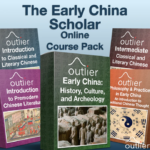
- Chinese News Bootcamp
- Philosophy and Practice in Early China
- Early China: History, Culture, and Archeology
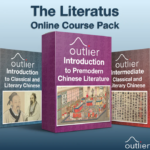 Introduction to Classical/Literary Chinese
Introduction to Classical/Literary Chinese- Intermediate Classical/Literary Chinese
- Advanced Classical/Literary Chinese
If you are learning Japanese, it's good to know that Outlier Linguistics have you covered there as well!
Conclusion of my review: Understand more, learn faster, and remember longer with the Outlier Chinese Character Masterclass
The Outlier Chinese Character Masterclass is a unique resource that gives you an understanding of the Chinese writing system that you won’t find elsewhere in English. When combined with the Outlier Dictionary of Chinese Characters, you have access to knowledge that would require a PhD in palaeography and literacy in Chinese to obtain elsewhere.
By teaching you how memory works and how to apply that to learning vocabulary in Chinese, this course also helps you avoid rote learning and find a strategy for learning that works in the long term. Combined with the insights into the Chinese writing system, this makes for a truly unique resource!
This is why I would have loved to have access to a course like this a decade earlier. This is also why I’m recommending that you go and check it out!
 For more information about the course, along with an FAQ, please check Outlier’s website:
For more information about the course, along with an FAQ, please check Outlier’s website:
Outlier Chinese Character Masterclass
Don’t forget that the discount code “hacking25” also applies here, in case you want to enrol! Please note that this discount applies to any other Outlier product you might purchase at the same time, including the character dictionary.
What do you think of the Outlier Chinese Character Masterclass?
While I have a lot of experience learning and teaching Chinese and have spoken with hundreds, if not thousands, of students over the years, I’m just one person. I have my own experiences, thoughts and opinions, which I have outlined in this review. But what do you think?
- Do you agree that this is indeed a unique resource?
- How did the course help you on your way to literacy in Chinese?
- Did you appreciate the same things I did?
- Are there things that could be improved that I didn’t mention?
Please leave a comment below or contact me in some other way!

Tips and tricks for how to learn Chinese directly in your inbox
I've been learning and teaching Chinese for more than a decade. My goal is to help you find a way of learning that works for you. Sign up to my newsletter for a 7-day crash course in how to learn, as well as weekly ideas for how to improve your learning!
